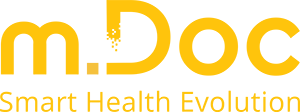The HIMSS in Orlando was worth the trip in many respects. What is particularly exciting, however, is how digital maturity measurement is currently changing in the USA. If you look closely, you now have the opportunity to shape digitization in German hospitals in such a way that a few evolutionary steps are skipped.
Broaden your horizons, think outside the box, or even change your perspective – there are many proverbs that encourage us to explore the realms beyond our own comfort zone from time to time. Why? Because these very steps promise growth, make us stronger, and innovations emerge on the basis of the newly gained experiences and impulses.
That’s exactly what some representatives of the German healthcare system did in March. They used the HIMSS Global Health Conference & Exhibition 2022 in Orlando – perhaps the most important event of the year for health information and technology – to gain inspiration for digitizing the German healthcare industry. Because let’s not kid ourselves: The U.S. clearly (still) has a head start here.
I was also there in Orlando. And what had a particularly lasting impact on me, and what I would like to talk about here, is the modernization of EMRAM, the Electronic Medical Records Model – a model for describing the degree of digitization in hospitals. Because what’s changing here right now, in my opinion, has the potential to change the entire industry.
Cell phone in the early 90s versus today
We can think of this modernization in much the same way as the development of the smartphone. While the Nokia 9000 Communicator was celebrated in the nineties for being able to send faxes, today’s smartphone generation Z doesn’t even know the Nokia brand or how to send a fax. It’s a similar story with the EMRAM. In 2005, the level of digitization was high when a clinic was organized as paperless as possible. In 2018, it was already about data-driven processes in clinics. And today, in 2022, Anne Snowdon, Chief Scientific Research Officer of HIMSS, talked in her presentation about the shift from procedural to clinical outcomes, from “patient engagement” to the clinical benefit of electronic patient records.
Here, the German need to catch up is already clear. After all, in order to be able to use the data from the electronic patient record, it must first be introduced across the board and filled with data. But that’s not the point here – it’s more a matter of looking at the patient, and that is currently shifting significantly with the modernization of EMRAM.
Patient interaction with meaning
This next evolutionary step is so important because digitization does not aim to collect as much data as possible for the sake of data. Just like digitization, data is not an end in itself; it is about generating added value. So instead of saying, “Dear patient, we provide you with your vital data via our patient portal,” the next logical step is, “Dear patient, here are your vital data and on this basis we derive the following recommendations for action.” With correspondingly radical patient-centeredness, there is added value for both practitioners and patients, which extends to the entire healthcare system if it improves “outcomes,” i.e., health maintenance or recovery.
To sum it up once again in all clarity: With this modernization, the new level of digitization of hospitals will no longer be measured by any technical standards. Progressive hospitals will be those that become partners in all health issues for their patients.
Can Germany skip a few evolutionary steps?
What has this “look beyond the end of one’s nose” achieved for the “German delegation” in Orlando? I honestly hope that the modernization of EMRAMS will also radiate to the DigitalRadar Hospital. After all, we are still in the middle of the tendering phase of the KHZG. And this is exactly where what I like to repeat comes into play: we have the chance NOW to set the course for the future with the KHZG funding. We don’t have to start with the Nokia 9000 Communicator when everyone else is already using the iPhone 13, the Samsung S22 or one of the other little high-tech wonders.
So we should make sure that the KHZG funding goes precisely into the projects that will help hospitals in this country achieve a high score in the modern EMRAM. And here, too, I’m really happy to repeat myself: we have an incredibly great opportunity, with the targeted use of resources and the selection of the right solutions, to take the digital transformation in giant steps in the right direction, so that we not only catch up again, but can perhaps also compete for the “overall victory” – for the benefit of the citizens of this country and our national economy. Why? Because we can!

